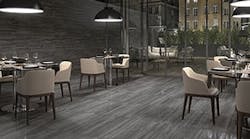The international Cersaie show holds a special place in the hearts of tile enthusiasts and product editors everywhere, and not just because it’s an excuse to travel to Bologna, Italy in September (although that’s probably one reason). It’s because Cersaie has become the place to spot the latest trends in porcelain and ceramic tile, thanks to its proximity to the continent’s leading tile producers and the vast number of products on display.
The year’s show, Cersaie’s 30th, was no different. More than 470 tile manufacturers served up a visual feast of pattern and color with geometric graphics, intentionally random patterns and encaustic-inspired tiles. Here’s a quick look at some of the most notable trends to emerge from the show; check out our blog, Inside Sources, for more pictures from the show floor.
mixed materials Patchwork tiles and compositions of varying colors, sizes and materials were popular, with many companies looking to give designers added opportunities for self-expression. A prime example of this could be found in Minoo, Marcel Wander’s third decorative tile collection for Bardelli. Intentionally designed for patchwork, the ornate 8 by 8-inch porcelain floor tiles are available in five silkscreen patterns reminiscent of Persian rugs.
Casamood offered a rich palette of mixable colors and surfaces through its Materia Project. Inspired by everything from rough cement walls to irregular panes of glass, the collection includes eight colors and surfaces with matching grout that can be coordinated or mixed and matched.
To create a mixed wood effect, EmilCeramica used HD technology to transform photographs of 50 fossilized wood blocks into the Petrified Tree collection. Bark reproduces the bark of fossilized wood with a rough-hewn, anti-slip finish while Core (in a natural or polished finish) reinterprets the petrified core of the tree.
Philippe Starck made one of the biggest splashes at the show with his first-ever ceramic tile collection, Flexible Architecture, produced by Italian manufacturer Ceramica Sant’Agostino. The tile joint, which is typically minimized or hidden entirely, becomes a central feature and decorative modular element in the line. It can be specified on one to four sides of the tile—or on no sides at all—to create an endless array of architectural compositions. A variety of thicknesses (7 and 12-millimeter), surfaces (matte and glossy) and colors (white, yellow, grey and greige) add to the product’s flexibility.
encaustic & majolica looks Although it can feel like neutrals and earth-tones have taken over as of late, a number of square ceramic tiles with bold, solid colors and striking patterns gave us hope. Some companies introduced traditional majolica motifs in new blown-out sizes and patchwork effects, while others were inspired by vintage encaustic tiles.
Azulej, Patricia Urquiola’s latest tile collection for Mutina, exemplifies this trend best. Inspired by ancient handcrafted majolica made of hydraulic cement, the 8 by 8-inch glazed porcelain tiles are available in three neutral base colors in a choice of nine patterns, or as a combination of 27 different designs.
Another avant-garde example comes from Refin’s Frame collection. Designed by graphic design firm Studio FM, the 30 by 30-inch tiles feature traditional decors from majolica tiles of the 19th and 20th centuries, but presented in a more graphic light. PageBreak
planks As the market moves towards longer slabs, tile companies are responding with new ranges of plank-sized tiles—some as long as 6 feet. Wood remains a popular design choice, although manufacturers are producing stone and concrete-inspired collections in these new plank sizes as well.
Sunrock by Atlas Concorde, a doppelganger for travertine, is available in a range of formats including 6 by 36 inches and 9 by 36 inches, while Coem’s Pietra del Friuli, inspired by stones found in Northeast Italy, comes in a 6 by 36-inch plank size. Imola Ceramica’s Vein collection looks like vein-cut or cross-cut marble and is also offered in the trendy 6 by 36-inch plank size.
Porcelain planks sporting a hand-planed effect were also popular this year; notable introductions included Root from Ceramiche Caesar; Planks by Ascot; AllWays by Mirage; and Silvis by Cotto d’Este (one of our favorites of the bunch).
ceramic fabric The influence of fashion on the world of tile could be seen in this year’s influx of tactile collections. From the femininity of lace to the luxurious sheen of silk, many ceramic tile manufacturers launched new collections inspired by the texture or appearance of a variety of fabrics.
Raw Edge’s second collection for Mutina called Tex is a rich, three-dimensional and multi-colored collection of 4.5 by 8-inch rhombus-shaped glazed porcelain tiles. Each of the eight available colors is made up of three shades and a range of textures taken from textiles that are randomly mixed.
I Tessuti is another designer collection, created by Elena Strafella for Cottoveneto, which features an interesting fabric-inspired composition of micro-mosaics. The range of decors includes: Scottish, Tweed, Shantung, Tartan and Twill. Also notable is the fabric-inspired Silkstone line from Marazzi, whose decorative ceramic wall tiles are inspired by Indian saris, Japanese kimonos, tulle and silk.
large sizes Super-thin tiles and giant slabs continue to grow in popularity among both designers and manufacturers. Thin tiles provide a versatile covering solution for nearly every surface, and large format tiles are typically easier to maintain and allow designers to concentrate on the lines and flow of a space.
The newest addition to Cotto d’Este’s super-thin (3-millimeter) and large (1 by 3 meters) Kerlite series, Exedra offers six types of marble looks and three finishes (natural, soft and lux). Because Kerlite is durable, light and easy to cut, it can also be used for kitchen countertops, basins, doors and other furnishings.
Similarly, Lightquarz is the fourth collection of large and super-thin laminated porcelain stoneware tiles from Panaria. Part of the company’s ZER0.3 line, the 3-millimeter tiles can be used for a wide number of custom solutions in bathrooms, kitchens and other gathering spaces.
Gli Alabastri di Rex by Rex is inspired by alabaster, with its natural luxury and symmetrical geometries, and is available in large 31.5 by 71-inch slabs. Also from the Florim Group, Industrial by Floor Gres reinterprets cement in porcelain slabs as large as 1.2 by 3 meters.


